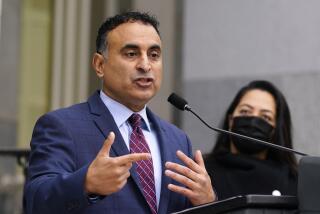House OKs Bill for Medical Error Database
- Share via
WASHINGTON — The House overwhelmingly approved legislation Wednesday that would create the first national network for reporting, analyzing and correcting medical errors, which were estimated to cause 40,000 to 98,000 preventable deaths each year.
The Senate has approved an identical measure. The House’s 428-3 vote means the bill will go to President Bush, who is expected to sign it.
Backers called the patient safety legislation a step toward encouraging doctors and other healthcare providers to report mistakes and hazards. Common medical errors include giving patients the wrong medications and lax sanitary practices, which can lead to infections at hospitals and nursing homes.
Such problems had received relatively little national attention until recently, despite the death toll. By comparison, highway accidents claimed 42,800 lives last year.
The bill would guarantee confidentiality to healthcare providers who reported problems, and would bar the reports from being used in malpractice suits and workplace and professional disciplinary proceedings. It would not block patients and families from using other medical records as evidence in a lawsuit.
After the House vote, Dr. J. Edward Hill, president of the American Medical Assn., said: “The healthcare community has long been committed to improving patient safety, and significant progress has been made through new technology, research and education. But federal legislation is the crucial element needed to truly expand broad patient safety reforms nationwide.
“When physicians can report errors in a voluntary and confidential manner, everyone benefits,” Hill said. “Future system errors can be avoided as we learn from past mistakes.”
A reporting system, added Rep. Michael Bilirakis (R-Fla.), a principal author of the bill, “will help create a culture of awareness to expose and address the systemic causes of medical errors instead of continuing the culture of blame, which hides and perpetuates them.”
The patient safety bill, which all members of the California delegation supported, may be one of the few pieces of healthcare legislation enacted this year by an ideologically polarized Congress.
Republican-backed measures to cap pain-and-suffering damages in malpractice cases, and to allow small business to circumvent state requirements that can increase the cost of health insurance, appear to have little chance in the Senate. Democrats are boycotting a commission that will recommend cuts in the Medicaid health insurance program.
Reporting systems that provide anonymity in exchange for information are used in aviation and have been credited with helping to reduce accidents.
Steven Wallace, the Federal Aviation Administration’s director of accident investigations, said the concept should produce results for medicine.
“As with aviation, the more insidious problem is going to be with low-risk situations,” Wallace said. “In the middle of a critical surgical procedure, I think everybody would be paying attention. It’s the routine procedures, such as the delivery of medications, that result in the more insidious errors.”
Under the bill, the Department of Health and Human Services would certify patient safety organizations to collect reports and analyze them for patterns of problems.
Analysts would try to pinpoint crucial initial events that prompted mistakes to cascade. The reports -- minus details that could identify individuals and institutions -- would be collected in a national database.
The safety organizations could be government agencies or private professional groups. Their analysts would be able to contact hospitals where a staff member had reported a problem and seek corrective action. The organizations could also put out safety alerts to the broader medical community.
Such efforts have shown results for anesthesiologists. Facing rising malpractice premiums and stung by media coverage of anesthesia accidents, the medical specialty created its own safety foundation in 1984.
That led to improved monitoring of patients under anesthesia, standard equipment in operating rooms, clearer guidelines for doctors and better training. The death rate from anesthesia accidents has dropped markedly. Malpractice premiums also have declined, after adjusting for inflation.
“The result has been the development of a safety culture in our specialty,” said Dr. Robert Stoelting, head of the Anesthesia Patient Safety Foundation.
The extent of medical errors gained national attention in 1999, when the Institute of Medicine, an independent organization that provided the government with advice on health policy, released “To Err Is Human: Building a Safer Health System,” a report that gave a comprehensive assessment of the problem.
Despite the urging of the American Medical Assn. and other groups, it took Congress six years to act.
“Politics is politics, I guess,” Hill said. “Being persistent is the key to getting something done.”
More to Read
Sign up for Essential California
The most important California stories and recommendations in your inbox every morning.
You may occasionally receive promotional content from the Los Angeles Times.










